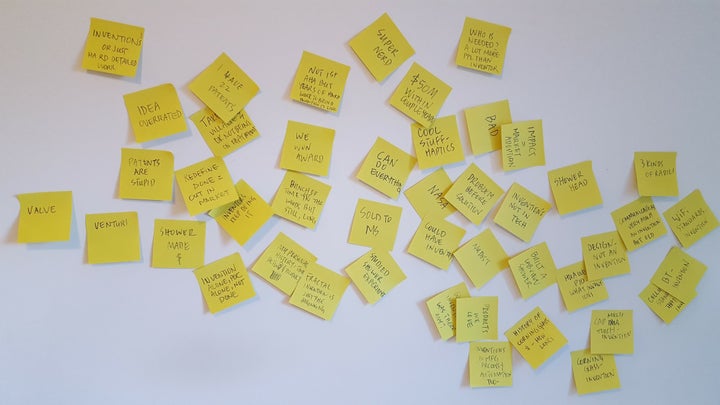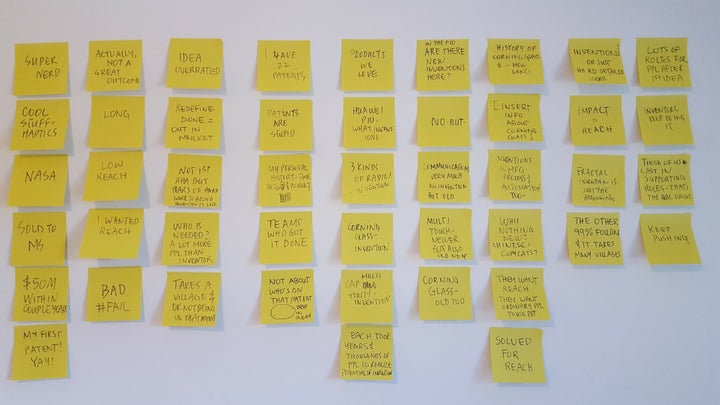Entrepreneurs and innovators give a lot of talks. Some are great. Others are really quite grim. How do we make sure we give a great talk when it's our turn?
As I think about the great talks I've heard, I realized there are three key things that make them work.
- Content: The raw material you are trying to communicate. This includes the information, any slides, and any other props or multimedia components.
- Delivery: The physical act of giving the talk.
- Narrative: The overarching structure that helps you communicate the content in an interesting way.
Great talks start with great narratives
There is much writing and even TED talks about the importance of storytelling in a talk. Kurt Vonnegut has an inimitable TED talk about the shape of a story that highlights the importance of emotional tension. All these are good tactics.
But in the end, what ties everything together is the narrative. Great content, great delivery and human interest stories can result in a good talk. A well developed narrative can make it great.
For a fundraising pitch, the narrative might follow the story of how the founders became inspired to solve a problem. They find that nothing on the market addresses this problem. They solve it with a wonderful solution. And behold! There is much money to be made. Now they invite the investors to join them in this journey by giving them money.
That's the narrative. It's the overarching framework in which all the facts, stories and sound bites fit.
Without an overarching narrative, you can end up presenting what amounts to an indented bullet list. Even the best speaker, with the most grippingly interesting raw content, will have trouble keeping the audience awake.
Draw inspiration from literature
Now, the example above is a really boring way to tell the story of a new venture. There are many other ways. One idea is to draw inspiration from classical narrative structures used in literature, and construct a talk that has a familiar structure to it. For example, the hero's journey or monomyth is a common template that can work for a lot of talks.
The importance of narrative cannot be overstated. Randy Olson, a marine biologist turned filmmaker and communications coach, has a book titled "Houston, We Have a Narrative: Why Science Needs Story". In this book, Randy presents the "And, But, Therefore" framework. This is a simple and effective way to help technical speakers create dynamic and interesting talks.
We won't go into details about this methodology. Read the book to learn more. Instead, we will talk about the mechanics of using the storyboard as a tool to construct the narrative itself.
Enter the storyboard
According to Wikipedia:
"A storyboard is a graphic organizer in the form of illustrations or images displayed in sequence for the purpose of pre-visualizing a motion picture, animation, motion graphic or interactive media sequence."
Storyboarding was developed by the good folks at Disney. And it works. After all, that's how Mickey Mouse cartoons were originally made. And it is one of the easiest ways for creating great narratives for talks and presentations.
When should I storyboard?
Contrary to common practice, the first step in constructing a new talk should never be to create starter slides. You should also not start by writing the script itself. The exception is when you have given variants of the same talk before - and you know exactly what you want to do.
Instead, Margie Zohn, founder of Zohn Coaching, recommends that you should start this way:
- Know your audience: Understand who you are presenting to, and what they are looking for in the talk
- Set goals: Define how you want your audience to think, feel and act after your talk.
This will help you figure out what content makes sense for the talk.
Once you've defined these two things, you are ready to storyboard the talk.
How can sticky notes help?
Nick Meyer, serial entrepreneur, fabulous speaker and Entrepreneur-in-Residence at the Martin Trust Center for MIT Entrepreneurship, teaches the method of storyboarding using sticky notes. You don't need to know how to draw. All you need is a stack of sticky notes, a black marker, and the ability to write legibly.
The first step in coming up with a storyboard for a narrative is to write down all your ideas on sticky notes. One idea per sticky note - keep it simple.

Then, start thinking about an overarching structure. Come up with the key points you want to make, and the order in which you want to make them. That is the beginning of your narrative.
As you work on the narrative, start picking sticky notes from the big, amorphous pile, and put them down in the order that you plan to present them.

In the picture above, the narrative runs left-to-right. Each column is a key element in the narrative. Each sticky note in a column represents an idea. The ideas are ordered top to bottom in the order they will be presented. This was an actual talk I was working on. Within 2 hours I had a starter narrative to build on.
What is special about sticky notes?
Sticky notes are not the only way to help you construct a talk. Some people prefer writing it down in a document. Others make placeholder slides and move them around. Still others use dedicated storyboarding software.
The reason why sticky notes are great, if you have a big enough wall, is that it is low-tech and physical. We don’t know why, but it seems to really help us with the creative process. You can see at one glance where all the ideas are. You can easily reorder them or toss the ideas. It is fast, visceral, and effective.
There is one other great benefit: You can quickly see which ideas don’t fit in the narrative. When you are in the amorphous pile stage, every idea seems important. But they are not all created equal. When you can’t make a column work well, or when you have one column that is way too long - it’s time to put that sticky note, or sometimes a whole column of it, in the discard pile. This doesn’t mean the idea is not important. But it might fit better in a different talk.
Storyboarding the talk before committing to the details is a very practical way to construct a great talk. Try it out! You might find that this method generates better talks in less time.
About the Author
Elaine Chen is a startup veteran, author, speaker, and product strategy and innovation consultant who has brought numerous hardware and software products to market. As Founder and Managing Director of ConceptSpring, Elaine works with innovative teams to help them define and build new products and services with the speed and agility of a startup. She is also a Senior Lecturer at the MIT Sloan School of Management and an Entrepreneur-in-Residence at the Martin Trust Center for MIT Entrepreneurship. Follow her on Twitter at @chenelaine.
For the latest research and commentary from MIT Sloan School of Management: Subscribe to http://mitsloanexperts.com or follow @mitsloanexperts on Twitter
